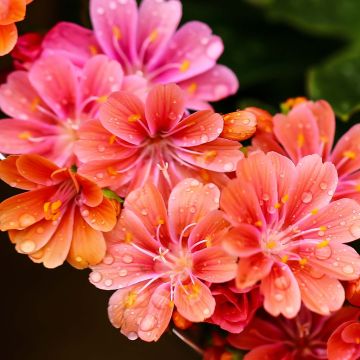Shipping country and language
Your country of residence may be:
Your country of residence is:
For a better user experience on our website, you can select:
Your shipping country:
-
Andorra
-
Austria
-
Belgium
-
Bulgaria
-
Canada
-
Chile
-
Croatia
-
Cyprus
-
Czechia
-
Denmark
-
Estonia
-
Finland
-
France
-
Germany
-
Greece
-
Hungary
-
Iceland
-
Ireland
-
Italy
-
Latvia
-
Lithuania
-
Luxembourg
-
Malta
-
Monaco
-
Netherlands
-
Poland
-
Portugal
-
Romania
-
Slovakia
-
Slovenia
-
Spain
-
Sweden
-
Switzerland
-
United Kingdom
We only deliver seed and bulb products to your country. If you add other products to your basket, they cannot be shipped.
Language:
-
French
-
German
-
Spanish
-
English
-
Italian
My Account
Hello
My wish lists
Log in / Register
Existing customer?
New customer?
Create an account to track your orders, access our customer service and, if you wish, make the most of our upcoming offers.
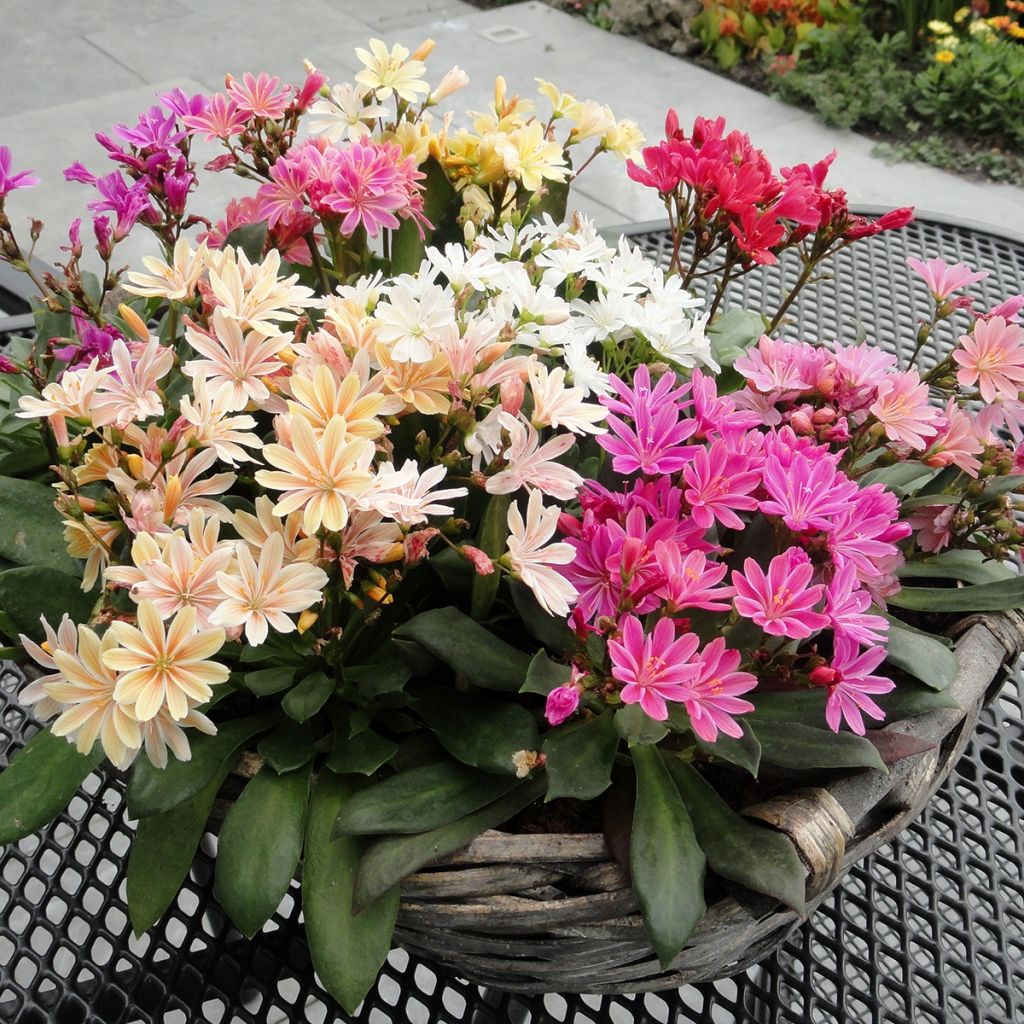

Lewisia cotyledon Elise en mélange
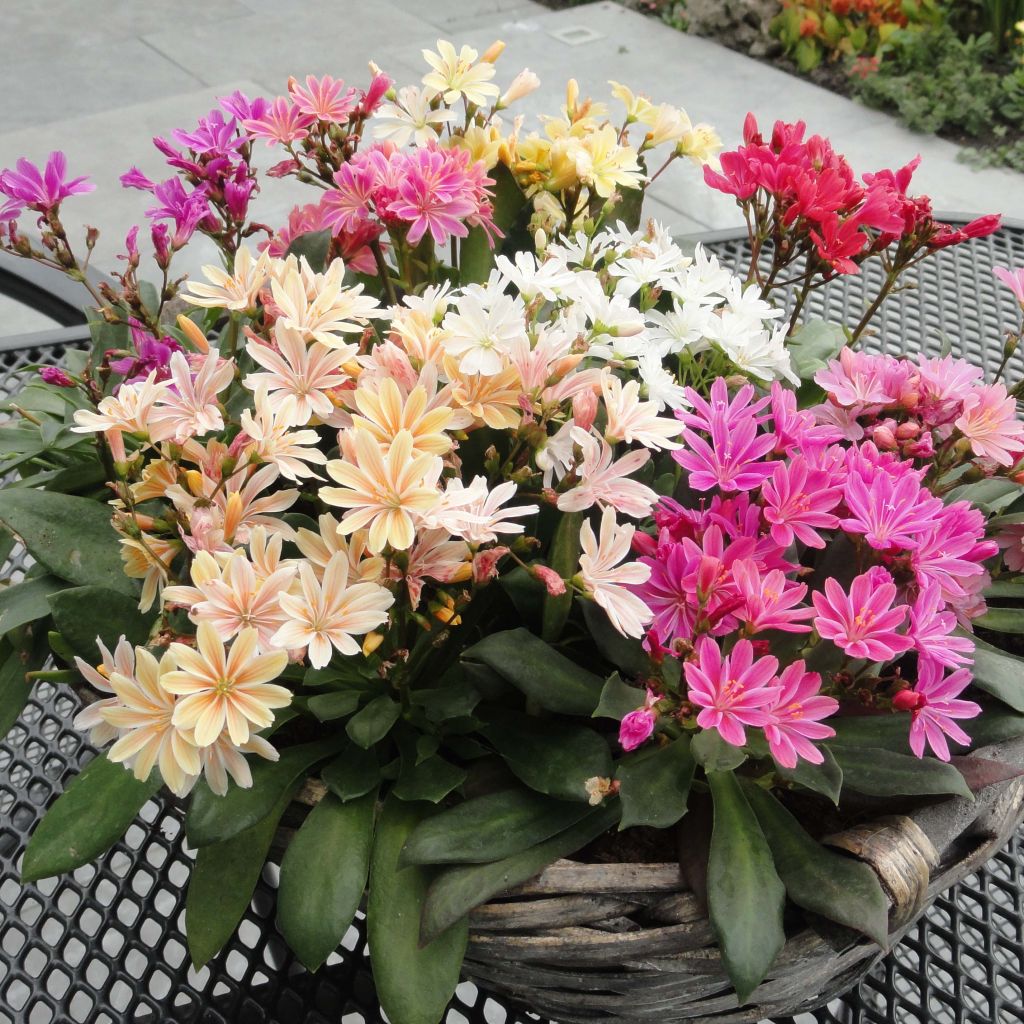

Lewisia cotyledon Elise Mix
Lewisia cotyledon Elise Mix
Lewisia cotyledon Elise Mix
Siskiyou Lewisia, Cliff Maids
I discovered this plant this year. I fell in love... Plants received this afternoon and immediately repotted. I can't wait to see how it turns out in a mix. As always, the promise of top-quality flowers. Very competent phone service. Fast delivery. I also appreciate the extra feature on the 'My Garden' website. A site that I would definitely recommend.
Florence , 04/04/2023
Order in the next for dispatch today!
Dispatch by letter from €3.90.
Delivery charge from €5.90 Oversize package delivery charge from €6.90.
More information
This item is not available in your country.
Schedule delivery date,
and select date in basket
This plant carries a 6 months recovery warranty
More information
We guarantee the quality of our plants for a full growing cycle, and will replace at our expense any plant that fails to recover under normal climatic and planting conditions.
From €5.90 for pickup delivery and €6.90 for home delivery
Express home delivery from €8.90.
From €5.90 for pickup delivery and €6.90 for home delivery
Express home delivery from €8.90.

Does this plant fit my garden?
Set up your Plantfit profile →
Description
Lewisia cotyledon 'Elise' is a new series of Siskiyou Lewisia selected for their ability to flower very young, from the first year of cultivation. These adorable little perennials bloom in spring and a large part of summer, with a multitude of brightly coloured star-shaped flowers, either solid or adorned with a bicoloured pattern, which varies depending on the plants. Beautiful in rock gardens, Lewisia 'Elise' are also highly decorative plants for sunny flower pots. Plant them in spring, in well-drained soil, in full sun or partial shade in hot climates.
Lewisia plants belong to the family of Portulacacaes, recently reclassified into the Montiaceae family. They are all native to the Rocky Mountains and were discovered in the early 19th century. They grow in small isolated populations in rocky crevices or gravelly scree. Lewisia cotyledon 'Elise' is an evergreen perennial, without stems, possessing an underground storage organ called a caudex and a reddish-fusiform, ramified, and pivot-shaped root system. It easily hybridizes and self-seeds in rocky terrain. The 'Elise' selection brings together some magnificent forms with very vivid or very tender colours: sumptuous shades of pink, salmon, orange, white, and yellow, on solid or bicoloured flowers. These plants have a loose clump habit, reaching about 25cm (10in) in all directions. They form succulent rosettes of dark glaucous green leaves, which turn red in the cold. The leaves measure 5 to 10cm (2 to 4in) long and are narrow, spatulate-shaped. Flowering takes place in spring, from March to June-July, varying depending on the climate. The flowers, about 3cm (1in) in diameter, are star-shaped corollas with 7 to 12 shiny, slightly fringed petals in various colours. They are grouped in small clusters carried by a stem that overhangs the leaf rosettes. They close at night.
A small plant with a captivating charm, Lewisia cotyledon 'Elise' catches the eye with its profusion of delicate and brightly coloured flowers, which seem to be 'grafted' onto rocks. Whether in a border, in a flower pot on a balcony, or placed at the top of a wall, it is easy to find a special place for this little marvel, sheltered from winter humidity, which it fears much more than the cold.
Lewisia plants are also known as 'Bitter root' because their edible roots, covered with a bitter skin, were traditionally harvested by indigenous tribes to be consumed once peeled and cooked, grilled, or dried, and even served as currency. It is said that a plant kept dry for five years is capable of resurrecting to produce beautiful flowers the following summer. This is at least the adventure experienced by a curious London botanist.
Note: Attention, our young plug plants are professional products reserved for experienced gardeners: upon receipt, transplant and store them under shelter (veranda, greenhouse, cold frame...) at a temperature above 14°C (57.2°F) for a few weeks before planting them outdoors once the risk of frost is definitively gone.
Report an error about the product description
Lewisia cotyledon Elise Mix in pictures
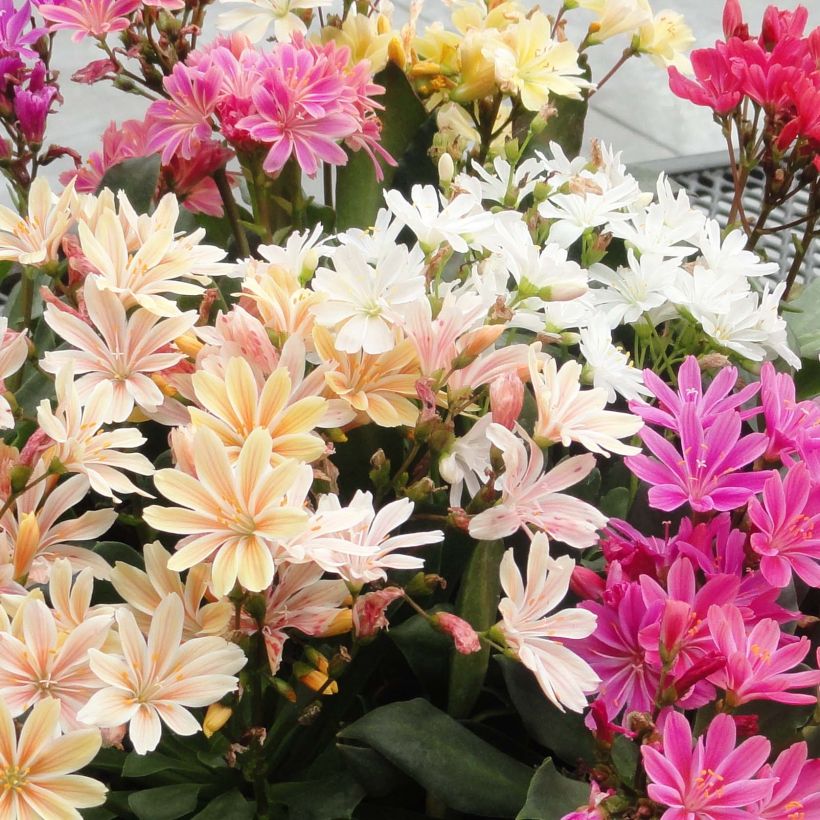

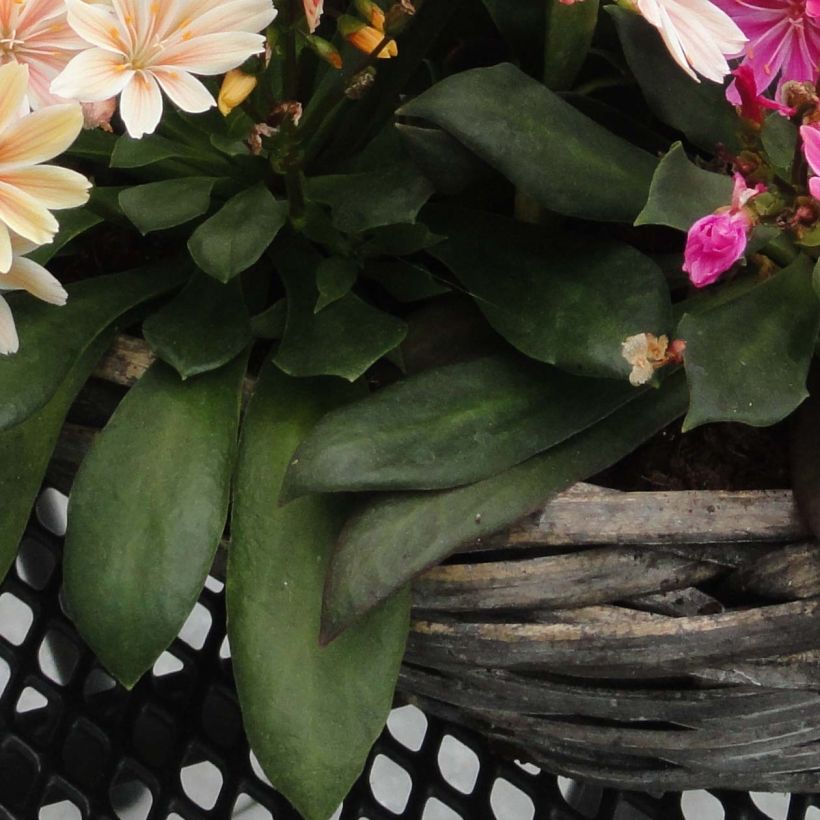

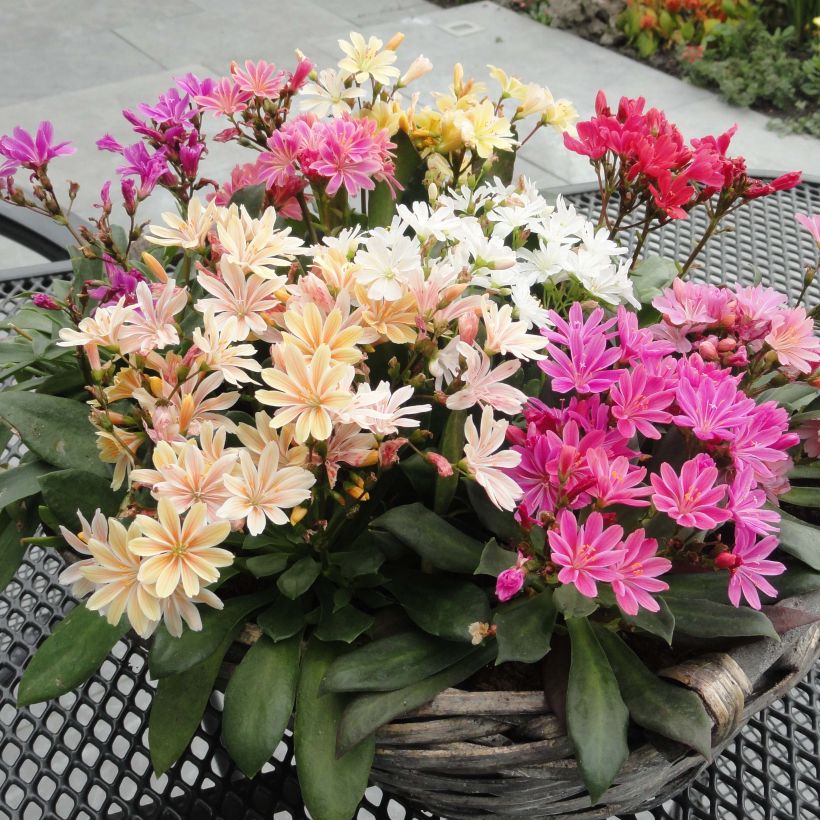

Flowering
Foliage
Plant habit
Botanical data
Lewisia
cotyledon
Elise Mix
Portulacaceae (Montiaceae)
Siskiyou Lewisia, Cliff Maids
North America
Other Lewisia
Planting and care
Lewisia cotyledon 'Elise Mix' is a very hardy plant. The choice of location is crucial: the soil must be well-drained but also fertile. In case of heavy soil, plant on a mound or add river sand and gravel to lighten the soil. Stagnant water around the roots of this plant would cause it to rot immediately. For pot planting, prefer a terracotta pot with drainage holes at the bottom. Create a layer of gravel or clay pellets to facilitate water drainage. The substrate should be composed equally of leaf compost, river sand, and compost. Never let water stagnate in the saucer and let the mixture dry almost completely between each watering. Apply liquid fertilizer every 15 days during the growth period. In the ground, fertilizer is unnecessary, and even harmful.
Plant Lewisia in full sun in cool climates, or in partial shade in the warmer regions. To faithfully bloom every year, this plant needs a cold season; do not bring your pots indoors during winter, but protect them from rain which, if too abundant for a long period, could destroy the plants.
Planting period
Intended location
Care
-
, onOrder confirmed
Reply from on Promesse de fleurs
Haven't found what you were looking for?
Hardiness is the lowest winter temperature a plant can endure without suffering serious damage or even dying. However, hardiness is affected by location (a sheltered area, such as a patio), protection (winter cover) and soil type (hardiness is improved by well-drained soil).

Photo Sharing Terms & Conditions
In order to encourage gardeners to interact and share their experiences, Promesse de fleurs offers various media enabling content to be uploaded onto its Site - in particular via the ‘Photo sharing’ module.
The User agrees to refrain from:
- Posting any content that is illegal, prejudicial, insulting, racist, inciteful to hatred, revisionist, contrary to public decency, that infringes on privacy or on the privacy rights of third parties, in particular the publicity rights of persons and goods, intellectual property rights, or the right to privacy.
- Submitting content on behalf of a third party;
- Impersonate the identity of a third party and/or publish any personal information about a third party;
In general, the User undertakes to refrain from any unethical behaviour.
All Content (in particular text, comments, files, images, photos, videos, creative works, etc.), which may be subject to property or intellectual property rights, image or other private rights, shall remain the property of the User, subject to the limited rights granted by the terms of the licence granted by Promesse de fleurs as stated below. Users are at liberty to publish or not to publish such Content on the Site, notably via the ‘Photo Sharing’ facility, and accept that this Content shall be made public and freely accessible, notably on the Internet.
Users further acknowledge, undertake to have ,and guarantee that they hold all necessary rights and permissions to publish such material on the Site, in particular with regard to the legislation in force pertaining to any privacy, property, intellectual property, image, or contractual rights, or rights of any other nature. By publishing such Content on the Site, Users acknowledge accepting full liability as publishers of the Content within the meaning of the law, and grant Promesse de fleurs, free of charge, an inclusive, worldwide licence for the said Content for the entire duration of its publication, including all reproduction, representation, up/downloading, displaying, performing, transmission, and storage rights.
Users also grant permission for their name to be linked to the Content and accept that this link may not always be made available.
By engaging in posting material, Users consent to their Content becoming automatically accessible on the Internet, in particular on other sites and/or blogs and/or web pages of the Promesse de fleurs site, including in particular social pages and the Promesse de fleurs catalogue.
Users may secure the removal of entrusted content free of charge by issuing a simple request via our contact form.
The flowering period indicated on our website applies to countries and regions located in USDA zone 8 (France, the United Kingdom, Ireland, the Netherlands, etc.)
It will vary according to where you live:
- In zones 9 to 10 (Italy, Spain, Greece, etc.), flowering will occur about 2 to 4 weeks earlier.
- In zones 6 to 7 (Germany, Poland, Slovenia, and lower mountainous regions), flowering will be delayed by 2 to 3 weeks.
- In zone 5 (Central Europe, Scandinavia), blooming will be delayed by 3 to 5 weeks.
In temperate climates, pruning of spring-flowering shrubs (forsythia, spireas, etc.) should be done just after flowering.
Pruning of summer-flowering shrubs (Indian Lilac, Perovskia, etc.) can be done in winter or spring.
In cold regions as well as with frost-sensitive plants, avoid pruning too early when severe frosts may still occur.
The planting period indicated on our website applies to countries and regions located in USDA zone 8 (France, United Kingdom, Ireland, Netherlands).
It will vary according to where you live:
- In Mediterranean zones (Marseille, Madrid, Milan, etc.), autumn and winter are the best planting periods.
- In continental zones (Strasbourg, Munich, Vienna, etc.), delay planting by 2 to 3 weeks in spring and bring it forward by 2 to 4 weeks in autumn.
- In mountainous regions (the Alps, Pyrenees, Carpathians, etc.), it is best to plant in late spring (May-June) or late summer (August-September).
The harvesting period indicated on our website applies to countries and regions in USDA zone 8 (France, England, Ireland, the Netherlands).
In colder areas (Scandinavia, Poland, Austria...) fruit and vegetable harvests are likely to be delayed by 3-4 weeks.
In warmer areas (Italy, Spain, Greece, etc.), harvesting will probably take place earlier, depending on weather conditions.
The sowing periods indicated on our website apply to countries and regions within USDA Zone 8 (France, UK, Ireland, Netherlands).
In colder areas (Scandinavia, Poland, Austria...), delay any outdoor sowing by 3-4 weeks, or sow under glass.
In warmer climes (Italy, Spain, Greece, etc.), bring outdoor sowing forward by a few weeks.
